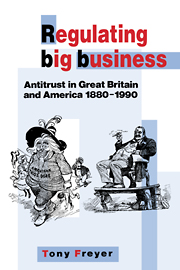Book contents
- Frontmatter
- Contents
- Preface
- Introduction
- 1 The response to big business: the formative era, 1880–1914
- 2 The divergence of economic thought
- 3 The political response
- 4 The courts respond to big business
- 5 The impact of World War I, 1914–1921
- 6 Tentative convergence, 1921–1948
- 7 A British antimonopoly policy emerges, 1940–1948
- 8 Uneven convergence since World War II
- Conclusion
- Notes
- Index
8 - Uneven convergence since World War II
Published online by Cambridge University Press: 21 January 2010
- Frontmatter
- Contents
- Preface
- Introduction
- 1 The response to big business: the formative era, 1880–1914
- 2 The divergence of economic thought
- 3 The political response
- 4 The courts respond to big business
- 5 The impact of World War I, 1914–1921
- 6 Tentative convergence, 1921–1948
- 7 A British antimonopoly policy emerges, 1940–1948
- 8 Uneven convergence since World War II
- Conclusion
- Notes
- Index
Summary
Throughout the post-war era the British and American policy response to big business gradually converged. Both nations experienced two significant merger waves, each of which peaked during the late sixties and eighties. By the 1980s the managerial organization of the British corporate economy approximated that of the United States. Not only had managerial capitalism finally displaced family capitalism in Britain, but the dominant corporate structure in each country was the large diversified corporation. The Monopolies Act of 1948 was merely the first step in a series of British and eventually European anti-cartel and merger measures which replaced business self-regulation with public control, facilitating the triumph of a corporate economy. In the United States a revival of antitrust enforcement from the late 1940s to the late 1960s, which nonetheless underwent transformation by 1990, also shaped corporate development. In Britain contrasting interest-group pressures and theories of economic efficiency sustained a new consensus favoring government intervention, while in America these same factors fostered the eventual demise of republican values.
THE PARAMETERS OF CONVERGENCE IN BUSINESS STRUCTURE
In both post-war nations similar patterns of business organization, government intervention, economic theory, and pressure group activity emerged. As had occurred in the turn-of-the-century United States, the British government's adoption of a reasonably clear anti-cartel policy combined with a greater toleration of mergers coincided with the triumph of managerial capitalism over family enterprise. The system of self-regulation did not disappear but it was circumscribed by a new system of public control. While post-war levels of corporate concentration were higher in Britain, in each country conglomerate and diversifying mergers were the norm by the 1980s.
- Type
- Chapter
- Information
- Regulating Big BusinessAntitrust in Great Britain and America, 1880–1990, pp. 269 - 323Publisher: Cambridge University PressPrint publication year: 1992



